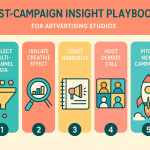Craft briefs that attract skilled artvertisers without ballooning your budget
Writing a crystal-clear brief is the fastest way to secure top-tier artvertisers without wrecking your marketing spend. In the next ten minutes you'll learn the structure, metrics, negotiation cues and timeline hacks that convert creative talent while protecting every euro.
Why the brief is your best cost-control lever

Artvertisers—those hybrid artists who translate visual storytelling into high-performing campaigns—thrive on precision. A concise, goal-oriented brief slashes costly revisions, shortens delivery cycles and signals professional respect that attracts A-level talent. Conversely, vague direction leads to ballooning scope, emergency add-ons and stressed relationships.
Set a razor-sharp campaign objective
- One sentence that states who you want to influence, what they should feel or do, and where the work will appear.
- Quantify success: “Increase landing-page sign-ups by 15 % in six weeks.”
- Align with your wider brand story so creatives can expand, not guess.
Lock success metrics early
Seasoned pros decide quickly whether a prospect knows what to measure. Share conversion, engagement or reach metrics up front and you'll stand out in any talent directory search. To dive deeper into analytics cues that reassure creatives, review the metrics artvertisers scan before hopping on a discovery call.
The anatomy of a cost-smart artvertiser brief
| Element | Loose brief | Cost-smart brief |
|---|---|---|
| Objective | “Boost brand love.” | “Lift Instagram saves by 20 % in Q3 among 18-25 UK segment.” |
| Visual references | Random Pinterest board | Curated moodboard with 5 approved references and brand palette codes |
| Deliverables | “A few social assets.” | 3×1080 px reels, 5×4:5 feed posts, static hero for website banner |
| Usage term | Unspecified | 12-month worldwide online + archive rights only |
| Timeline | “ASAP.” | Kick-off 02 May, first draft 12 May, go-live 31 May |
Include fit-for-purpose moodboards
Go beyond screenshots. Annotate each image with why it resonates—colour mood, layout flow, texture. This context lets artvertisers suggest cost-efficient techniques without guesswork. For timings that align research, concept and rollout, use the workflow in this timeline guide.
Clarify usage and licensing
Extended license requests can double project fees. If your campaign sits only on owned channels, say so. If you might expand later, note “option to extend” and negotiate rates now.
Negotiation playbook: secure value without overpaying
- Reference budget brackets. Check current ranges—see how brands group fees in 2025 artvertiser budget brackets—and open with a realistic window, not a vague “What do you charge?”
- Incentivise efficiency. Offer milestone payments: 40 % on concept approval, 40 % on final assets, 20 % after performance report. Predictable cashflow motivates swift hand-offs.
- Swap scope, not rate. If quotes bust your ceiling, remove formats or shrink usage duration instead of pushing hourly fees down.
Hidden budget bloaters (and how to remove them)
- Excessive file versions. Limit deliverables to the formats your media plan genuinely needs.
- Last-minute copy tweaks. Lock copy before production starts—text overlays are costly late in motion design.
- Undefined sign-off chain. Too many approvers add idle hours. Nominate one decision maker.
- Missing brand assets. Supply logos, fonts and hex codes on day one to avoid paid “asset hunt” time.
Timeline tricks that keep creatives on rate
Every rush fee hides inside an unrealistic milestone. Follow these timeline habits:
- Reverse schedule. Start from your launch date and work backwards, adding buffer days at each revision phase.
- Approve in 24 h. Promise feedback within one business day; delays push freelancers onto other projects and back-burner yours.
- Batch reviews. Collect feedback from all stakeholders before sending it; multiple micro-rounds waste budget.
Data snapshot: How detailed briefs cut budget overruns
Source : HubSpot State of Marketing 2024
Quick checklist before pressing “Send”
- Objective & KPI written in one sentence
- Target audience persona attached
- Moodboard annotated with brand colours
- Exact deliverables and dimensions listed
- Usage term and territories specified
- Milestone dates & one decision maker named
- Budget window or tier indicated
- All brand assets zipped and linked
- Directory link to verified artvertiser profiles for faster shortlisting
Mini-quiz: Are you brief-ready?
FAQ
- How long should my artvertiser brief be?
- Aim for one to two pages plus attachments. Enough to be precise, not a novella.
- Can I reuse assets in another market later?
- Yes, but negotiate an extension clause now to avoid premium last-minute fees.
- What's a fair revision limit?
- Industry standard is two rounds. More than three often signals unclear direction.
- Do I need different briefs for video and static assets?
- The core stays the same. Add format-specific specs (fps, max file size) in an annex.
- Where can I find vetted professionals fast?
- Browse curated profiles in the Artfolio artvertiser directory linked above to compare portfolios, rates and turnaround times in minutes.
Wrap-up & next move
A tight, data-driven brief magnetises the best artvertisers and keeps your spend predictable. Use the checklist today, save 20 % or more on production tomorrow. Ready to see proposals roll in? Post your brief to Artfolio's directory and watch qualified responses land in your inbox.
Need deeper guidance? Our playbook on engaging creatives via direct messaging walks you through first outreach scripts that convert without noise.











